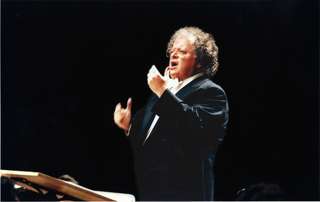|
Back
The Breath and Breadth of Life New York
Stern Auditorium, Carnegie Hall
12/20/2009 -
Sir Edward Elgar: Sea Pictures, Opus 37
Gustav Mahler: Symphony No. 5
Stephanie Blythe (Mezzo-soprano)
The Met Orchestra, James Levine (Music Director and Conductor)

J. Levine (© Koichi Miura)
The following are reasons for staying alive:
1, A New York Sunday afternoon, the sky a cloudless cerulean blue, over Central Park glistening with snow, entering Carnegie Hall to hear James Levine conducting the finale of Mahler’s Fifth Symphony.
2. All the other reasons.
Truth is, that when conductor Levine directed the last consecrating chorale from the finale of Mahler’s great work, nothing more remained to say or do or imagine. He had done it all. And not having heard the Maestro in several months, this performance seemed doubly blessed, doubly hallowed. In other words, Mahler himself probably heard in his own mind what James Levine conducted with his Met players.
His orchestra was top-rate. Not a single trumpet or horn solo, not one of the brass choir made an iota of a mistake, and the sounds glowed. More important, in the intricate polyphony and fugue of the finale, Mr. Levine revealed the individual threads from the complex tapestries. Nor did the strings falter in the famous Adagietto. One tends to dismiss this short movement as being too “pretty”, as being the background for Visconti’s Mahler-influenced Death in Venice. When performed correctly, when, as Mahler specifies, the violins can glide from one note to another without sounding schmaltzy, when the strings work to bring out the full emotional power, rather than movie music, we have something extremely special.
Levine was singular in another respect. The Boulez generation of conductors theoretically demotes the concept of emotion in music, and Mr. Levine promotes it grandly. Who is right? Remember that when Mahler rehearsed his own music, he would frequently cry and wring his hands, overcome with emotion. Which is why, these last two movements left me also in a state of satisfied elation.
Then again, the finale is not the most difficult movement here. Those first three movements are so confoundingly at odds with each other that no conductor can afford to take liberties with them. Mahler knew what he was doing, and Mr. Levine knew that too. Nothing was exaggerated or contrived. Yes, the funeral march was stunning–part terrifying, part agonizing, yet the final measures, the flute and pizzicati soft, the snare drum softer, was a most delicate movement. For the second movement, Mr. Levine retained the agony, the timpani pounding out, the horns blaring. When turning to the major key and the first chorale, Levine eased the tautness into triumph with a musical inevitability.
The third movement was like a wonderful painting, for I don’t know of any conductor alive today who can blend the horn obligatos with the winds so delicately, so correctly.
At the start if the finale, Mr. Levine did something I have rarely heard. Like the First Symphony, the solo horn, oboe, bassoon, clarinet and flute became actual bird songs, echoing each other, playing against each other. It was no more than 10 measure, before the strings started, but what measures they were, an avian nocturne leading into the jokey Allegro giocoso–and that finale echoed perhaps only at the end of the Ring.
I don’t mean to ignore the opening Elgar Sea Pictures, sung so beautifully by mezzo Stephanie Blythe. There were a few times–as in the last verse of Sabbath Morning at Sea or the final song–where I would have preferred more expanse, less volition. But who can fault Mr. Levine? Each song rumbled with a maritime undertow, thanks to Sir Edward Elgar’s masterful orchestration.
That was a splendid beginning, from one of the most splendid works of Sir Edward. Written but five years before the Mahler Fifth, it had a luscious loving adoration of the sea. The Mahler, though, did not have such Victorian confidence. Life was joy and nightmare, the delight of dance and birdsong, the trembling onset of death. That we have James Levine to unveil the depths of both works is an elemental reason to live. thrive, and bless all the joyful seasons.
Harry Rolnick
|